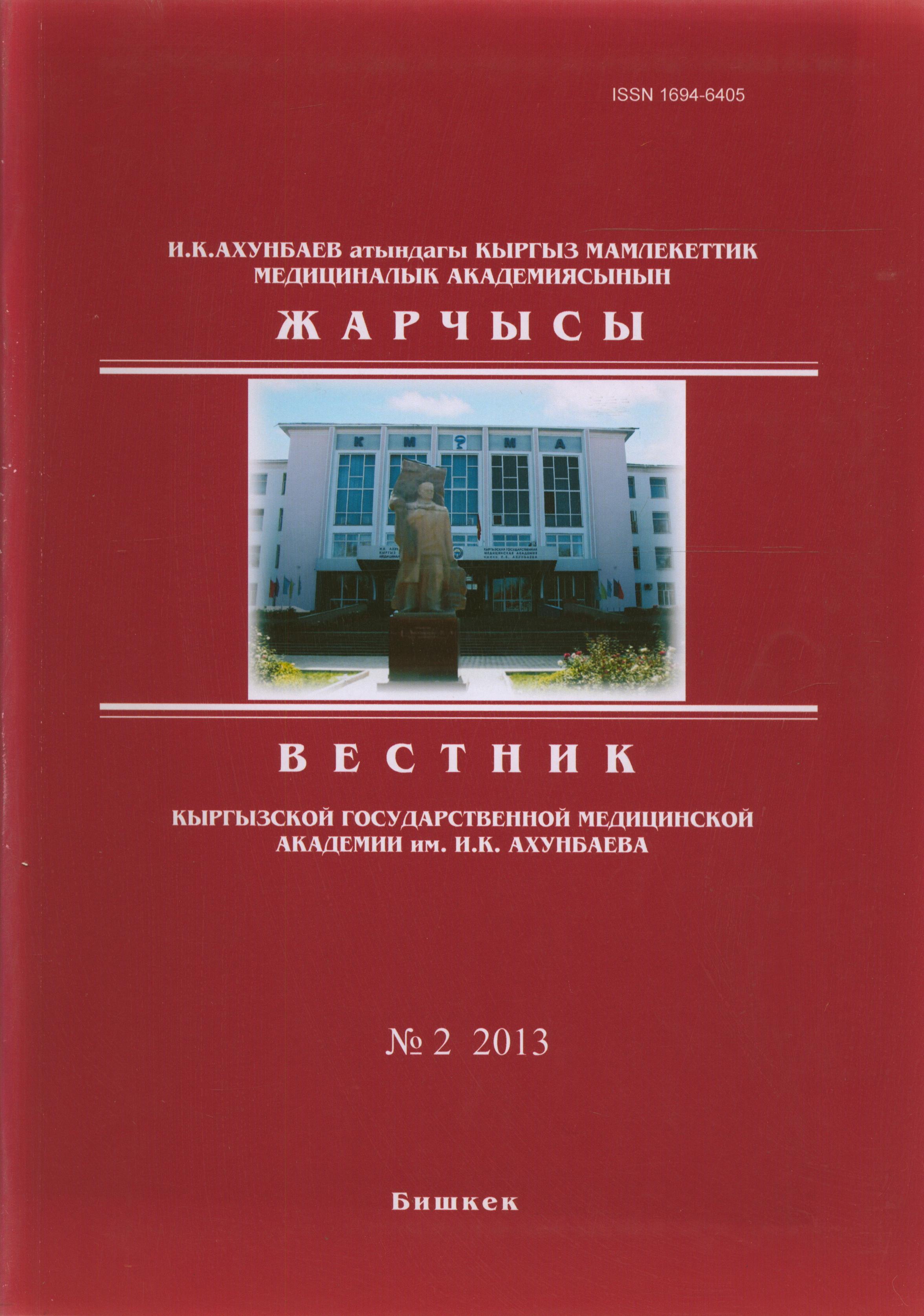THE ROLE OF COAGULOPATHY IN MASSIVE OBSTETRIC HEMORRHAGE AND ANTIFIBRINOLYTIC THERAPY
Abstract
In this report discussed the role of coagulopathy in the causes of massive obstetric hemorrhage and experience of 258 (of which 51, 5% non-removal of the uterus) operations with ligation of vessels and holding antifibrinolytic therapy (tranexamic acid) in critical situations in maternity institutions o f the Kyrgyz Republic.
Keywords:
massive obstetric hemorrhage, coagulopathy, uterine and/or hypogastric artery ligation, recombinant factor, tranexamic acid.References
1. Бутта З.А., Хан Я.ГТ. Здоровье женщин и новорожденных детей в Кыргызстане и Чуйской области: оценка и обоснование вмешательств.- Бишкек, 2009, - С.51.
2. Ешходжаева А.С., Калиева А.С., Абазбекова Н.С., Аскеров А.А. Краткий обзор ситуации в сфере охраны здоровья матери и ребенка в Кыргызской Республике за 2008-2009 гг.- Бишкек, 2010, - С.46.
3. Кудаяров Д.К. Охрана материнства и детства в Республике и вклад Объединения (Ассоциации) врачей педиатров Кыргызстана//Ж. Здоровья матери и ребенка, 2011, Т. 3, №1.- С.13-16.
4. Здоровье населения и деятельность организаций здравоохранения Кыргызской Республики в 2010 году.- Бишкек 2011, С.7.
5. Ан А.В., Пахомова Ж.Е. Критические состояния при акушерских кровотечениях/ Вопросы гинекол., акуш и перинат., 2010, т.9,№4, С.33-36.
6. Айлямазян Э.К., Репина М.А., Кузьминых Т.У. Еще один взгляд на проблему и женскихъ болезней. - 2008, - №3, - С.3-11.
7. Баев О.Р., Давыдов А.И. Послеродовое кровотечение: акушерская тактика и интенсивная терапия.//Вопросы гинекологии, акушерства и перинатологии., 2011,- Т. 10,- №6 - С.65-69.
8. Грищенко О.В., С.В. Коровай. Тромбоэмболия легочной артерии в акушерской практике. //Акушерство, гинекология, репродуктология,- (381) 2011 (тематический номер)
9. Джаманаева К.Б, Ли С.И. Тромбоцитопения при беременности. Возможные осложнения родов, послеродового периода. // Ж. Денсаулык сактауды дамыту журналы,- Спец выпуск №1, 2012, - Часть 1- С.62-65.
10. Мусуралиев М.С., Макенжан уулу А. Улучшения качества жизни и проблемы безопасного материнства.// Ж. Здоровье матери и ребенка.- 2009, Т. 1, Приложение 1. - С.49-53.
11. Мусуралиев М.С, Макенжан уулу А. Инновации лечения массивных кровотечений в акушерстве.//Вестник НАН КР. - 2011, №1,- С.110-118.
12. Мусуралиев М.С., Макенжан уулу А. Качество и проблемы оказания неотложной помощи при критических состояниях в акушерстве.// Ж. Здоровье матери и ребенка, 2011, Том 3, №1,- С. 139-142.
13. Мусуралиев М.С., Макенжан уулу А., Омурбекова М.М. Проблемы материнской смертности при кровотечении в акушерстве./Ж. Вестник КГМА, 2012, № 4,-С . 126-130.
14. Пархоменко А.Н., Иркин О.И., Лутай Я.М. Симпозиум: Тромбоэмболия легочной артерии: алгоритмы диагностики и лечения.// Ж. Медицина неотложных состояний,- 2011, -3 (34.)
15. Серов В.Н., Маркин С.А. Критические состояния в акушерстве - М., 2003,- С. 526-527 (704 с)-
16. Серов В.Н., СавелеваГ.М., Стрижаков А.Н. и др. Профилактика и терапия массивной кровопотери в акушерстве. (Медицинская технология). - М., 2011, С. 23.
17. Сухих Г.Т., Серов В.Н., Федорова Т.А. и др. Инфузионно-трансфузионная терапия при коагулопатических послеродовых кровотечениях. (Медицинская технология) - М., 2009, - С.15.
18. Федорова ТА. Рогачевский О.В. Анакушерских кровотечений. //Журнал акушерства А.В Принципы инфузионно-трансфузионной терапии массивного акушерского коагулопатического кровотечения.// Акушерство и гинекология, 2010, № 6,-С.142-148.
19. Bapayeva G., An Z., Bacci А. Основные причины материнской смертности в акушерской практике: первый опыт и итоги конфиденциального аудита в Республике Казахстан. // Entre Nous. Европейский журнал по сексуальному и репродуктивному здоровью, 2011, № 74,- С .168-17.
20. Sukhanberdiyev К., Ayazbekov А., Issina A., et al. Опыт внедрения аудита «Анализа угрожающих жизни акушерских осложнений» в Казахстане: улучшение практики ведения кровотечений.// Entre Nous. Европейский журнал по сексуальному и репродуктивному здоровью , 2011, № 74,- С .18-19.
21. Ananth CV, Nath СА, Philipp С. The normal anticoagulant system and risk of placental abruption: protein C, protein S and resistance to activated protein C. J Matem Fetal Neonatal Med 2010; 23:1377-83.
22. Angstmann Т., Gard G., Harrington T. et al. Surgical management of placenta accreta:a cohort series and suggested approach//Am J. Obstet. Gynecol. - 2010. - Vol. 202. - № 1,- P.38.
23. Antepartum Haemorrhage Green-top guideline №60, 151 edition , November 2011.- 23 p.
24. American Thoracic Society Documents An Official American Thoracic Society/Society of Thoracic Radiology Clinical Practice Guideline: Evaluation of Suspected Pulmonary Embolism In Pregnancy / 2011. - Am J Respir Crit Care Med Vol 184. pp 1200-1208, 2011. // (Ann N. Leung, Todd M. Bull, Roman Jaeschke, et al.) DOI: 0.1164/ rccm.201108-1575ST
25. Begley CM, Gyte GM, Murphy DJ, et al. Active versus expectant management for women in the third stage of labour. Cochrane Database Syst Rev 2010; (7):CD007412
26. Bhide A, Thilaganathan B. Recent advances in the management o f placenta previa. Curr Opin Obstet Gynecol 2004; 16: 447-51
27. Bolliger D, Gorlinger K, Tanaka K. Pathophysiology and treatment of coagulopathy in massive hemorrhage and hemodilution. Anesthiology 2010; 11: 1205-19.
28. Camuzcuoglu H , Toy H , Vural M, et al. Internal iliac artery ligation for severe postpartum hemorrhage and severe hemorrhage after postpartum hysterectomy/ Obstet Gynaecol Res. 2010 Jun;36(3):538-43.
29. Cantwell R, Clutton-Brock T, Cooper G, et al. Saving Mothers’ Lives: Reviewing maternal deaths to make motherhood safer, 2006-08. The Eighth Report of the Confidential Enquiries into Maternal Deaths in the United Kingdom. BJOG 2011; 118:1-203.
30. Davenport R, Curry N, Manson J, et al. Hemostatic effects o f fresh frozen plasma may be maximal at red cell ratios of 1:2. J Trauma 2011; 70: 90-95.
31. Department of Health. Saving Mothers 2005-2007. Fourth Report on Confidential Enquiries into Maternal Deaths in South Africa. Pretoria: Department of Health; 2009.
32. Khan KS, Wojdyla D, Say L, et al. WHO analysis of causes of maternal death: a systematic review. Lancet 2006; 367:1066-74.
33. Khan K, Zamora J, Lamont RF, et al. Safety concerns for the use of calcium channel blockers in pregnancy for the treatment o f spontaneous preterm labour and hypertension: a systematic review and meta-regression analysis. J Matem Fetal Neonatal Med 2010; 23:1030-8.
34. Knight M, Kurinczuk JJ, Spark P, Brocklehurst P; United Kingdom Obstetric Surveillance System Steering Committee. Cesarean delivery and peripartum hysterectomy. Obstet Gynecol 2008; 111:97-105
35. Levy JH. Antifibrinolytic therapy: new data and new concepts. Lancet 2010; 376: 3—4.
36. Lonkhuijzen Luc, Stekelenburg Jelle, van Roosmalen Jos. Maternity waiting facilities for improving maternal and neonatal outcome in low-resource countries. // Cochrane Database of Systematic Reviews: Reviews, 2009. - Issue 3 John Wiley & Sons, Ltd Chichester, UK DOI: 10.1002/14651858. cd06759. - pub2, 2009.
37. Maternal mortality in India: a 20-year study from a large referral medical college hospital West Bengal / S. K. Bhattacharyya, A. K. Majhi, S. L. Seal et al. // J. Obstet. Gynaecol. Res. 2008. - Vol. 34, № 4. - P. 499-503
38. Maternal mortality and severe morbidity from sepsis in the Netherlands / H. M. Kramer, J. M. Schutte, J. J. Zwart et al. // Acta Obstet. Gynecol. Scand. -2009. Vol. 88, № 6. - P. 647-653.
39. Mukherjee S & Arulkumaran S. Post-partum haemorrhage. Obstet Gynaecol Reprod Med 2009; 19: 121-126. doi: 10.1016/j. ogrm.2009.01.005.).
40. Hussian R., Dlugacz Y.,D. Good eatery finding near-misses and preventing errors// Internft. Forum on Guality and Safery. April 2008; Paris, France abstr. 29: 2008.
41. Horton R. What will it rake to stop maternal death? Sep 23, 2009 The Lancet.
42. Pariente G, Wiznitzer A, Sergienko R, et al. Placental abruption: critical analysis of risk factors and perinatal outcomes. J Matem Fetal Neonatal Med 2010; 24:698-702.
43. Peitsidis P. Kadir RA. Antifibrinolytic therapy with tranexamic acid in pregnancy and postpartum. Expert Opin Pharmacother.. 2011 Mar;12(4):503-16. Epub 2011 Feb 4.
44. Placenta praevia, placenta praevia accrete and vas praevia: diagnosis and management. Green- top guideline №27, January 2011. - 26 p
45. Rasmussen S, Albrechtsen S, Dalaker K. Obstetric history and the risk of placenta previa. Acta Obstet Gynecol Scand 2000; 79:502-7.
46. Roberts I, Shakur H, Ker K, Coats T. Antifibrinolytic drugs for acute traumatic injury. Cochrane Database Syst Rev 2011; 1: CD004896 .
47. Royal College of Obstet. and Gynaecol. Maternal Collapse in Pregnancy and the Puerperium. Green-top Guideline No. 56. London: RCOG; 2011.
48. Sekhavat L, Tabatabaii A, Dalili M et al. Efficacy of tranexamic acid in reducing blood loss after caesarean section./ J Maternal Fetal Neonatal Med 2009; 22: 72-75.
49. Silver RM, Landon MB, Rouse DJ, et al.; National Institute of Child Health and Human Development Maternal-Fetal Medicine Units Network. Maternal morbidity associated with multiple repeat cesarean deliveries. Obstet Gynecol. 2006; 107:1226— 32.
50. Smith J, Mousa HA. Peripartum hysterectomy for primary postpartum haemorrhage: Incidence and material morbidity. J Obstet Gyn. 2007; 27:44-47
51. Stein PD, Matta F, Yaekoub AY. Incidence of amniotic fluid embolism: relation to cesarean section and to age. J. Womens Health (Larchmt). 2009; 18(3): 327-9.
52. Iwata A, Murayama Y , Itakura A , et al. Limitations of internal iliac artery ligation for the reduction of intraoperative hemorrhage during cesarean hysterectomy in cases of placenta previa accreta. J Obstet Gynaecol Res. 2010 Apr; 36(2):254-9.
53. Tocce IK, Thomas V & Teal S. Scheduled hysterectomy for second-trimester abortion in a patient with placenta accreta. Obstet Gynecol 2009; 113:568-570.
54. The CRASH-2 Collaborators. Effects of tranexamic acid on death, vascular occlusive events, and blood transfusion in trauma patients with significant haemorrhage (CRASH-2): a randomised, placebo-controlled trial. Lancet 2010; 376: 23-32.
55. The CRASH-2 collaborators. The impoitance of early treatment with tranexamic acid in bleeding trauma patients: an exploratory analysis of the CRASH-2 randomised controlled trial. Lancet 2011; published online March 24. DOI: 10.1016/ S0140-6736(ll)60278-X.
56. Van Roosmalen J., Zwart J. Severe acute maternal morbidity in high-incom countries. Best Practiiice&Research Clinical Obstretrics and Gynaecology, 2009; Vol.23, P.297-304.
57. Welsh A., C. McLintock, S. Gatt et al. Guidelines for the use of recombinant activated factor VII in massive obstetric haemorrhage// Australian and New Zealand Journal of Obstetrics and Gynecology, 2008; 48: 12-16
58. Wise A., V. Clark. Challenges of major obstetric haemorrhage/ Best Practice & Research Clinical Obstet. and Gynaec. 24 (2010) 353-365
59. Orhan U.; Kars, Bulent; Buyukbayrak, et al. The effectiveness of bilateral hypogastric artery ligation for obstetric hemorrhage in three different underlying conditions and its impact on future fertility /Journal of Maternal-Fetal and Neonatal Medicine, Volume 24, Number 10, October 2011, pp. 1273-1276(4)



